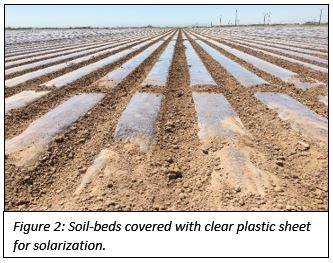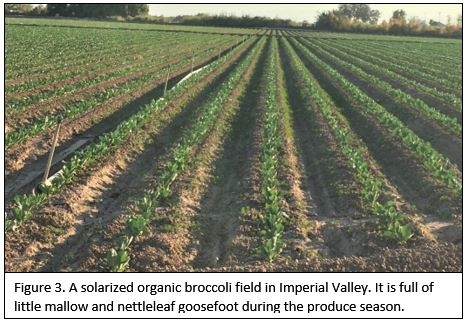As we are in the mid-summer, many fields in the low desert region are preparing for soil solarization. Soil solarization is a widely adopted pest control method by organic growers in the low desert region. With the increase in organic production acreage in recent years, we are seeing more fields implementing soil solarization during summer.
Soil solarization is a method for controlling soilborne pathogens, insects, nematodes, and weed seeds & seedlings by disinfesting soil by the solar heat. Solarization is implemented during summer months, where soil is heated by covering with transparent polyethylene mulch/tarp. The plastic covering permits solar radiation/energy to penetrate and trap in the soil; thereby, building heat in the soil (Fig 1). The higher temperature disinfects soil and provides pest control. Moisture is also important component for soil solarization because wet soil is better conductor of heat than dry soil.
There are four important considerations for soil solarization.
- Field preparation/cultivation and removal of clods and plant debris that might hinder soil solarization
- Listing soil beds (north to south bed orientation is desired)
- Irrigation of soil beds (soil moisture 75% or greater of field capacity)
- Laying out the plastic sheet on the beds (beds are covered with plastic sheets for about 4 to 6 weeks)
Clear or transparent plastic sheet is most effective for solarization, because it allows the entry of solar radiations to the soil bed (Fig 2). Colored-plastic sheet is less effective because they reflect light and solar radiation does not penetrate through as effectively as in the clear plastic sheet. Plastic sheets are found in various thickness and selection has to be made appropriately. Thin plastic sheet (1 mil) provides greater heating but is also more susceptible to tearing during lay out or later from wind pressure. Slightly thicker plastic sheets (1.5 to 2 mils) is advantageous for windy conditions (FYI, 1 mil = 0.001 inch or 0.025 mm).
Weed control
Soil solarization is found to be effective in controlling various annual weeds. Some weed species are highly sensitive to solarization while other species are moderately sensitive to less sensitive. In general, winter annual weeds are more sensitive to soil solarization compared to summer annuals. Likewise, weeds with hard seed coat are less sensitive to soil solarization. Some of the weed species found in low desert region, such as common purslane, nettleleaf goosefoot, little mallow, littleseed canarygrass are less sensitive to soil solarization (Fig 3). For the perennial weed species such as nutsedge spp., johnsongrass, and bermudagrass soil solarization controls their seeds but has less effect on perennial structures such as tuber, rhizome, and stolon. Solarization is less effective on perennial structures buried deep into the soil (> 6 inches deep).
For more information on soil solarization, here is a good publication from UC Vegetable Research and Information Center.
- Elmore, CL, JJ Sapleton, CE Bell, and JE Devay (1997) Soil Solarization: A Nonpesticidal Method for Controlling Diseases, Nematodes, and Weeds. UC Vegetable Research and Information Center. Available at: http://vric.ucdavis.edu/pdf/soil_solarization.pdf


